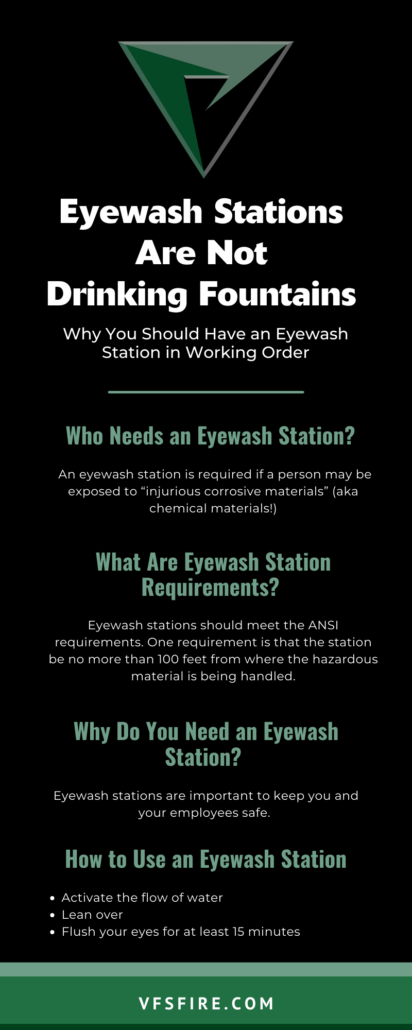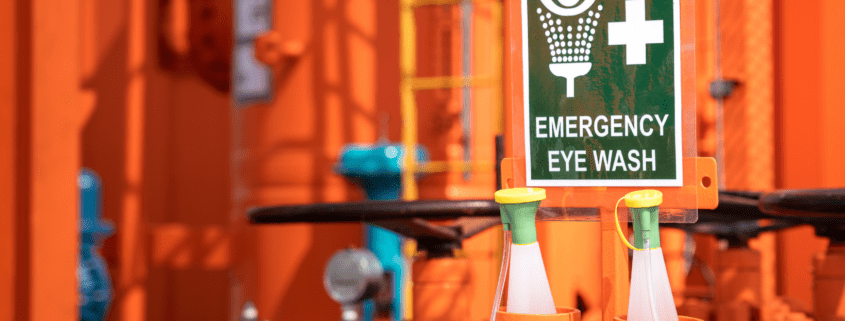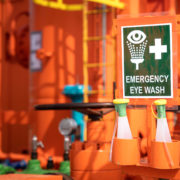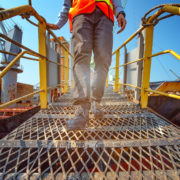Eyewash Stations are Not Drinking Fountains
Why You Should Have an Eyewash Station in Working Order
You heard it here first—an eyewash station isn’t a fancy drinking fountain. If you need a drink of water, we recommend finding another source… like maybe an actual water fountain.
In all seriousness, eyewash stations are important pieces of equipment that reduce the major risks associated with chemical exposure (think: chemical-related eye injuries). Let’s discuss why you might need a properly functioning eyewash station.
Who Needs an Eyewash Station?
Based on the requirements of the Occupational Safety and Health Administration (OSHA), an eyewash station is required if a person may be exposed to “injurious corrosive materials” (aka chemical materials in laboratories).
The Material and Safety Data Sheet (MSDS), included with the chemical, indicates if the chemical is injurious corrosive.
Eye-related chemical injuries can lead to:

- Corneal perforation
- Corneal ulcers
- Cataracts
- Glaucoma
- Retinal damage
- Eye loss
- And more
What Are Eyewash Station Requirements?
In 2009, the ANSI updated the standard for emergency eyewash stations. According to the new updates, if you or employees are working with hazardous chemicals, the station should be:
- Installed and maintained correctly (i.e. the injured person should be able to flush their eyes for at least 15 full minutes)
- At sites with any hazardous materials
- No more than 100 feet from where the material is being handled
- Within a 10-second walk of the hazardous material
- Unobstructed by other machinery or equipment
- Up to ANSI standard with respect to location, rate of water flow, fluid angle, water temperature, user position, and station location
All of these regulations are set in place so that if an emergency situation arises, the exposed person can quickly seek treatment to avoid severe damage.
Why Do You Need an Eyewash Station?
Eyewash stations are an important piece of keeping you and your employees safe. If someone is exposed to a hazardous substance, especially a corrosive chemical, immediate treatment is critical to reduce injury.
Proactively treating a hazardous chemical exposure in the first 10 to 15 seconds after exposure can reduce damage and injury because it flushes away the substance by providing quick decontamination.
We get it, accidents happen. A chemical exposure can occur even with all of the right safety precautions in place or when a person isn’t donning personal protective equipment. Having an emergency eyewash station provides an additional layer of safety to reduce the damage chemicals cause.
How to Use an Eyewash Station
First, anyone working with or near hazardous chemicals should be wearing personal protective equipment (i.e. goggles, face shields, gloves). This will reduce the chances of chemical exposure.
If an eye emergency does occur, it’s imperative to act quickly. You have 10 to 15 seconds from the time of initial exposure to flush out the chemical before the substance causes serious injury. Understand how to use your eyewash station before an emergency situation arises; it’s a race against the clock when you’re dealing with hazardous chemicals.
If chemical eye exposure occurs, walk to the eyewash station immediately as a peer notifies emergency services. Once at the station, push the foot pedal or hand lever to activate the flow of water. Then, lean over and hold your eyelids open and allow the water to flow over the eyeballs for at least 15 minutes, or until emergency responders arrive with further instructions.
While flushing your eyes for 15 minutes, roll your eyes around so the water can flush the entire surface of the eyes, and remove contact lenses. Even if only one eye was contaminated, wash both eyes.
If you need a visual guide, watch our pal, Andy Bernard, demonstrate below.
For more information on what else businesses need to know about eyewash stations, click here.








